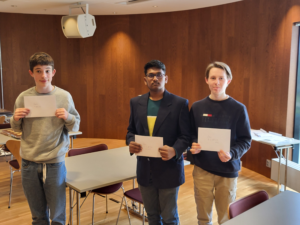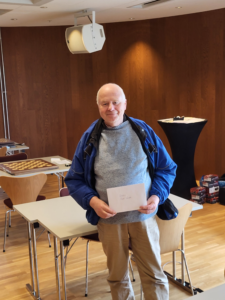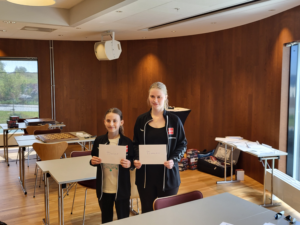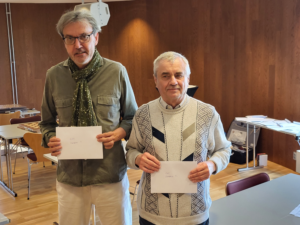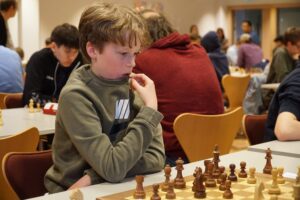Open Round 10
THE LAHLUM SHORT REPORT 10
First board duel between GM Vitaly Sivuk and GM Platon Galperin was drawn without any exciting moments and within half an hour after both players had arrived this morning. Same was the second board game between FM Aksel Bu Kvaløy and IM Pawel Teclaf. Much more excitement was seen in hard fought battles on board three and four. The outcome in both games was wide open after three hours, but the fourth hour gave decisive white wins for WIM Savitha Shri Baskar against IM Tor Fredrik Kaasen and GM Konstantin Tarlev against FM Stanislaw Zylka. Galperin following this won an unshared first prize at an outstanding 8.0/10, while Teclaf, Sivuk, Kvaløy, Baskar and Tarlev shared the second to sixth place at a very strong 7.0/10. Kvaløy prolonged his GM norm to ten rounds, while Baskar prolonged her IM norm to ten rounds and also won an unshared best woman prize. These remained the only title norms of the tournament as Zylka lost a difficult black game against Tarlev, while American WGM Gulrukhbegim Tokhirjonova (2340) just missed her third IM norm as she failed to win a clearly better position as white against GM Titas Stremavicius.
The winner of the GM group was confirmed within half an hour after the start of round 10, as leading GM Platon Galperin (2528) got a draw after 14 moves as black against GM Vitaly Sivuk (2489). The game was an open Ruy Lopez leading to a sound repetition of checks – well known from hundreds of other top level games. The players are friends and travel companions, but the draw anyway would have been fairly rational from both sides. Galperin as the higher rated player guaranteed his unshared first prize of 3000 Euros, while Sivuk assured himself a notable prize. Platon Galperin also won the blitz tournament the day before the main tournament, and in short had nine very successful days in Stavanger. Now passing 2565 while still aged 19, he seems very likely to pass 2600 well before Christmas.
Second board between FM Aksel Bu Kvaløy (2321) and IM Pawel Teclaf (2575) also was an open Ruy Lopez and also was drawn in a balanced position within a few minutes after both players had arrived. Again this was fairly rational from both side.: Kvaløy prolonged his GM norm to 10 rounds, increased his ELO to 2415 and guaranteed himself a notable moneyprize. Teclaf was black, had no norm chances anyway and guaranteed a notable and for him very welcome moneyprize. Kvaløy making the third IM norm and passing 2400 was not that much of a surprise following his strong form the last two months. Still it was of course a sensation that the 14 year old reached 7.0/10 without any lost games, defeated two GMs, reached his first GM norm and shared the second prize.
As Teclaf, Sivuk and Kvaløy all had accepted a draw within the first hour, Norwegian IM Tor Fredrik Kaasen (2480) as the last player starting up this morning at 6.5/9 could win an unshared second prize of 2000 Euros – if able to win his third board game as black against WIM Savitha Shri Baskar (2418). The Sicilian Najdorf opening first appeared better for white and her pair of bishops. Kaasen´s chances however were considered promising as he at move 30 had reached a balanced and double edged position with queen, rook, bishop and five pawns on each side – with 34 minutes against 11 left on the clock. White however speeded up and took over the initiative following a well timed 32.g6! followed by 33.gxf7+, opening the position around black´s king. White had a pressure before black at move 34 blundered his pawn at a6, and after the time control reached a rook and opposite coloured bishop endgame in which white´s extra passed pawn at a5 soon decided. Savitha following this had made a 10 rounds IM-norm with half a point overscore! Very well deserved she won an unshared best woman prize in addition to a shared second prize. Kaasen following a too uneven tournament finished just around his expected score and won a prize of only 40 Euro, while a draw in the last round would have given 840 and a win 2000 Euros. Margins definitely were small and stakes high in the fourth hour on the third board.
Fourth board duel between Ukrainian GM Konstantin Tarlev (2598) and Polish FM Stanislav Zylka (2415) in the meantime also became a hard fought four hours battle. Top rated Tarlev needed a full point to save a substantial moneyprize, while Zylka needed a full point to score his third IM norm. The opening was a Caro-Kann Advance in which white after six moves had pawns at g4 and h5. White´s kingside initiative first gave him a slight edge after both players had castled long, although black after 29 moves balanced this and white´s pair of bishops with a queenside initiative. Black at this stage hade almost half an hour against four minutes on the clock. Snatching a pawn with 30.— Nxd4?! however opened the position for the white bishops. Although consequent, intervening at c2 with the rook following a queen exchange was a blunder leading to a decisive loss of material. Black resigned maybe a little bit early instead of making his move 38, but white for sure was winning in this endgame with two rooks and three pawns against rook, bishop and three pawns. First rated Tarlev had a shaky tournament and left nine ELO points in Stavanger, but after all reached 7.0/10 and won 840 Euros.
Polish GM Szymon Gumularz (2587) and Indian GM Suri Vaibhav (2595) both could reach a substantial moneyprize if winning their internal duel on board 5. The second and third rated GM of the tournament obviously were unlucky to be paired against each other in this situation. This was a real game lasting two and a half hours, but both players looked a bit disillusioned and a draw was agreed after 22 moves in a balanced although far from dead drawn position.
Sixth board between WGM Gulrukhbegim Tokhirjonova (2340) and GM Titas Stremavicius (2541) also ended up a draw, although this was hard fought five hours battle. Again this was natural following the starting point: Tokhirjonova as white needed a win to reach her third IM norm, while Stremavicius as black could share the second prize in case of a successful counterattack. White in a Sicilian Sozin line castled long and started a pawn storm on the kingside around move 12. Black had a pair of bishops and a fairly sound position, but came under pressure as he following a not well timed center push with 14.— e5?! had to exchange his dark squared bishop. Although black finally castled short, white due to his two rooks in the d-file and the strong d5 outpost appeared clearly better after 21 moves. The kingside attack reportedly was a misunderstanding, as black was fine after exchanging queens. Black in turn however became overambitious as he went for a counterattack with the kingside pawns and placed his king at g6. Having only one and a half minute against half an hour on the clock, Stremavicius blundered with 29.— g4? – but then Tokhirjonova in turn missed her golden chance to win an exchange with 30.Rd6+! White still won a pawn with a lasting pressure, but during mutual time pressure white made some mistakes allowing black to activate his pieces and force a dead drawn rook endgame. Tokhirjonova was a bit unlucky not to make her third IM norm this week, but winning 14 ELO points she still passed 2350 and moved closer to the IM title. If reaching 2400, she will for sure make at least one more IM norm on the way up. Stremavicius despite his fantastic start in the end won only 40 Euros and lost two ELO points.
Croatian GM Davorin Kuljasevic (2553) had a pole out tournament here in Stavanger, and in the final round missed the last chance for a small moneyprize as he wasted a winning attack as white against Polish FM Marcin Molenda (2406). It is tempting here to explain the question marks around move 30–40 as time trouble mistakes, but truth is that none of the players were seriously short of time either. Molena successfully escaped into a drawn rook and bishop endgame, but this GM draw was too little and too late for him to reach an IM norm.
IM Vaishali Rameshbabu (2418) versus GM Alex Fishbein (2366) was another hard fought game, which continuned more than half an hour after all other players had finished. White got some pressure in an Italian position in which the queenside became more and more messy. As the smoke finally disappeared on the queenside just before the time control, the conclusion was that white had somehow won a kingside pawn. The remaining endgame with two rooks, knight and five pawns for white versus two rooks, knight and four pawns for black was close to winning for white, as black struggled with a weak pawn at c7 and the less active knight. Vaishali kept up the pressure well and after five hours had reached an endgame with rook and c-pawn versus rook – easily winning as black´s king was offside on the kingside. GM Alex Fishbein following this ended below his expected score, while his 21 year old son Mitch Fishbein (2120) made a notable plus following a stubborn last round draw as white against GM Erik Blomqvist (2521). The Swedish GM had no problems from the opening and after 30 moves was a sound pawn up in the rook and minor piece endgame, but despite two passed queenside pawns he failed to win. The win here probably never was easy, but the outcome still was illustrating for Blomqvist´s pole out tournament.
Neither Norwegian IM Mads Vestby-Ellingsen (2357) or German IM Jakon Pajeken (2417) had much to fight for at this stage, and not unexpectedly their meeting on the ninth board ended up a sound draw. German IM Theo Gungl (2370) was more ambitious and got some initiative after starting up with 1.d4 Nf6 2.c4 g6 3.h4!? as white against the Norwegian junior champion Sondre Melaa (2231). Black after 22 moves had reached about balanced chances, as white was a pawn up with a dubious pawn structure. Taking back the pawn with 23.— Qxc2? however was a greedy mistake. Following this white won an exchange and demonstrated a winning attack before the first time control. Melaa still could be well satisfied with a performance well above 2300. Sergey Eliseev (1970) versus FM Marius Fromm (2457) was another Norwegian-German duel also won by the German, although this too was a hard fought and interesting game. Eliseev after 24 moves had reached a position with queen, two rooks, one bishop and six pawns against queen, two rooks, bishop and five pawns. Black due to his better pawn structure and safer king had full compensation, but white apparently had good drawing chances. Opposite coloured bishops however here favoured the attacker. White lagged almost 50 minutes behind on the clock when he blundered with 25.c4??, somehow overlooking 25.— Rf6! with decisive threats against the key f3 pawn. Fromm reached a zero result following this win, while Eliseev despite this loss had a great performance of 2273 and won 134 ELO points.
Today´s most exciting start came in the Israelian duel between IM Yahli Sokolovsky (2461) and WFM Michelle Katkov (2142). Katkov here had the much better preparation, coming almost one hour ahead on the clock with a promising position and a dangerous passed pawn. Sokolovsky however made good use of all the time he spent, and some three hours later on succeeded to win after hanging on his extra pawn into the endgame. The last round also saw some surprising draws from talented young Norwegians: 13 year old Tromsø planer Sivert Schanche Tørfoss finished off his first international title tournament with a draw as white against 16 year old FM Shazil Shehzad (2310). Shehzad despite a promising position after seven rounds finished just around his expected score, while Tørfoss had a performance of 2220 and won 141 ELO points – more than any other players in Norway Chess Open. 12 year old Evsuld Myagmarsuren (2181) at 5.5/10 confirmed his new playing strength around 2200 and picked up a few more points following a long last round draw as black against 71 year old GM Lother Vogt (2314). Myagmarsuren here noteworthy refused two draw offers from the GM and kept a slight pressure all into the endgame. Legendary Vogt at 5.0/10 dropped below 2300, but still enjoyed the tournament a lot and much praised the strong play of Myagmarsuren and other of his very young opponents. The best veteran prize was shared between Vogt and 60 year old IM Oliver Brendel, also reaching 5.0/10 with a somewhat better ELO performance and buchholz following a last round win.
First board in the Open was generation duel between 71 year old Ole Smeby (1928) and 19 year old Rajesh Jeyanth (1469). Black more or less equalized by more or less sound means in a declined Queen´s Gambit. The center pawns were exchanged early, leaving after two hours a position with queen, rook, knight and five pawns on each side. Later the game balanced all the way into a dead drawn rook endgame with one rook and one passed pawn for both players. Second board duel between 12 year old Gokay Serbes (1338) and 17 year old Jonas Gryte (1626) was an Accelerated Dragon Sicilian in which white for some moves was a pawn up. Black however had much compensation and kept a strong initiative after regaining the pawn. Gryte increased the advantage until winning pawns and had a controlled win in the endgame.
Jeyanth and Gryte sharing the first and second prize at 8.0/10 was very surprising as Gryte was rated number 9 and Jeyanth number 16 before the first round. On the other hand it came very natural and well deserved as the tournament developed: Both players started up with 4.5/5 and later stayed on the top boards for all the remaining rounds. Jeyanth was the only player in the Open to survive 10 rounds without any lost game, while Grythe was the only player to win seven games. Jeyanth after winning all his first three games had the best buchholz as well as the best ELO performance, although the moneyprizes were shared equally. Jeyanth had won 88 new ELO points when leaving Stavanger, while Gryte had 81 points more when not leaving. From what we saw of their games here, both are very likely to win more games and ELO points in their upcoming tournaments.
Also strongly underrated Vetle Støren (1534) was in third position before last round, but soon ran into problems as white in a Sicilian against Noa Brakestad (1626). Black before 20 moves, following a tactical Rxb4, won two bishops for a rook with a decisive advantage. White fought on into the endgame, and after both players had promoted a pawn he creatively tried to complicate things with a tactical rook sacrifice at h6. 15 year old Brakestad looked a bit shocked but still handled the situation very well, coolly cashing in the rook and then evacuating his king over to the queenside. Brakestad might have been a bit lucky to reach an unshared third prize as he following a slow start had only the tenth best ELO performance of this group. He however demonstrated his capacity in the second half of the tournament and passed all his competitors for the third prize thanks to a strong spurt with 3.5/4 in round 7–10. Vetle Støren despite the round 10 loss finished fourth, won more than 100 ELO points and had the third best ELO performance.
Second rated German Christian Strahl (1918) after two hours was considered a likely third prize winner, since he came fine if not better from the English opening as black against Polish Marcin Rzepka (1417). Black established a space advantage on the kingside and appeared to have a promising attack coming up. Strahl however ran seriously short of time and overlooked a decisive counterattack. 16 year old Rzepka following this reached 6.5/10 and won 131 ELO points – more than any other player in the Open. Strahl handled the situation very well, but finishing fifth of course was disappointing for him. Smeby at sixth place also lost some ELO, but still won the prize for best veteran. Unfortunately Smeby was the only player above age 60 in this field. Although he was a well qualified veteran prize winner, the future of this prize should be discussed with such a low number of participants. For myself I have concluded that if an Open at all should have such a veteran prize, it better be a senior prize for players above 50. True enough if that case the number of competitiors here would have increased only from one to two. More than two thirds of the participants were below 20, and junior players occupied eight out of the top ten places in the list. The youngest and lowest rated here was the talented 12 year old Turk Gokay Serbes (1338), finishing in eight place with 6.5/10 and winning 71 ELO points.
Fortunately, competition was much harder for the best woman prize, with 20 % of the players in the Open being females. This prize was shared between the two best Danish players, 12 year old Sarah Sima Derlich (1522) and 14 year old Kathrine Lindegaard Bruntse (1603), both reaching 6.5/10 including one walk over draw. Derlich lost only one game and in the last round won confidently as black against 10 year old local Sophie Damiano (1303), also by the way scoring far above her expected. Kathrine Lindegaard Bruntse had a buchholz and ELO performance slightly below Derlich, but also made a solid plus after she in the last outplayed David Hellesøy (1606) as white in a Grünfeld-Indian. Black´s exchange sacrifice in this game backfired as white later had a material advantage and soon also demonstrated that she had the more dangerous attack. By far the best result among the unrated players had the local 14 year old William Høyland, finishing undrawn at 5.0/10 with a performance of 1319.
The Open all the way had a remarkable fighting spirit and each round produced many exciting and interesting games, although the quality of course varied a lot. While three out of the 73 starting players in the GM group came to play less than seven games, all the 45 players who started up the Open played seven rounds or more.
Obviously, many players in the GM group as well as in the Open arrived with ambitions for more points, higher ELO performances and fewer lost games. Still, following the reactions we have received so far, we hope and believe that all the players enjoyed the tournament and left Stavanger with some new and memorable experiences. Compared to last year the number of players increased from 99 to 118, and the level of the GM group also improved notably: 24 participants this year had a GM, IM or WGM title, compared to 13 participants from Norway Chess Open 2022.
To end on a happy note, we thank all the players for their very good behaviour during this year´s tournament – and much hope that we will be back with an even bigger and stronger Norway Chess Open in 2024!
